

The geomagnetic field was quiet on November 24. The high latitude magnetometer at Andenes recorded quiet to unsettled levels.
Solar flux density measured at 20h UT on 2.8 GHz was 83.4 - decreasing 28.3 over the previous solar rotation. (Centered 1 year average SF at 1 AU - 183 days ago: 80.72). The Potsdam WDC planetary A index was 4 (STAR Ap - based on the mean of three hour interval ap indices: 4.1). Three hour interval K indices: 22111101 (planetary), 11111221 (Boulder), 21111103 (Andenes).
The background x-ray flux is at the class A6 level (GOES 16).
At the time of counting spots (see image time), spots were observed in 6 active regions using 2K resolution (SN: 91) and in 4 active regions using 1K resolution (SN: 59) SDO/HMI images.
Region 12896 [S18W61]
decayed slowly and quietly.
Region 12897 [N15W47] decayed slowly and quietly.
Region 12898 [S23E30] was initially recorded at
the position of AR S7200 by SWPC, then SPWC corrected their mistake and
placed AR 12898 at the position of AR S7197. The region developed further
and could produce C flares.
Spotted regions not observed (or interpreted
differently) by SWPC:
New region S7202 [S02W06] emerged near noon and
developed slowly. This is an SC24 group. Another SC24 group was observed at noon
at N04E04, it's unusual to observe two groups from the previous cycle active at
the same time 2 years after the solar minimum.
New region S7203 [S20W36] emerged with tiny spots.
New region S7204 [S24W23] emerged with a tiny spot.
C2+ flares:
| Magnitude | Peak time (UT) | Location | AR | Recorded by | Comment |
November 22-23: No obviously Earth directed CMEs
were observed in available LASCO imagery.
November 24: A filament eruption was observed beginning at 12:47 UT
in the southern hemisphere. A partial halo CME was observed afterwards in
LASCO imagery. Components of this CME may be headed towards Earth and could
cause a disturbance on November 28.
[Coronal hole history (since October 2002)]
[Compare today's report to the situation one solar rotation ago:
28 days ago
27 days ago
26 days ago]
A southern hemisphere coronal hole (CH1043) rotated across the central meridian on November 23-24. A recurrent northern hemisphere coronal hole (CH1044) could become Earth facing on November 27.

Long distance low and medium frequency (below 2 MHz) propagation along paths north of due west over upper middle and high latitudes is fair. Propagation on long distance northeast-southwest paths is poor.
The geomagnetic field is expected to be quiet on November 25. On November 26-27 there is a chance of unsettled and active intervals due to effects from CH1043. November 28 could see the arrival of the November 24 CME with unsettled and active conditions possible.
| Coronal holes (1) | Coronal mass ejection (2) | M and X class flares (3) |
1) Effects from a coronal hole
could reach Earth within the next 5 days. When the high speed
stream has arrived the color changes to green.
2) Effects from a CME are likely to be observed at Earth within 96 hours.
3) There is a possibility of either M or X class flares within the next 48 hours.
Green: 0-30% probability, Yellow: 30-70% probability, Red: 70-100% probability.
(Click on image for 2K resolution).
4K resolution.
Compare to the previous day's image. 0.5K image
When available the active region map has a coronal hole polarity overlay where red (pink) is negative and blue is positive.
Data for all officially numbered solar regions according to the Solar Region Summary provided by NOAA/SWPC, all other regions are numbered sequentially as they emerge using the STAR spot number. Comments are my own, as is the STAR spot count (spots observed at or inside a few hours before midnight) and data for regions not numbered by SWPC or where SWPC has observed no spots. SWPC active region numbers in the table below and in the active region map above are the historic SWPC/USAF numbers. SWPC data considered to be not sufficiently precise (location, area, classification) are red colored.
| Active region | SWPC date numbered STAR detected |
Spot count | Location at midnight | Area | Classification | SDO / HMI 4K continuum image with magnetic polarity overlays |
Comment | ||||
|---|---|---|---|---|---|---|---|---|---|---|---|
| SWPC/ USAF |
Magnetic (SDO) |
SWPC | STAR | Current | Previous | ||||||
| 2K | 1K | ||||||||||
| 12896 | 2021.11.13 2021.11.14 |
1 | 2 | 1 | S17W62 | 0010 | AXX | AXX |
 |
 |
area: 0004 |
| 12897 | 2021.11.15 2021.11.16 |
1 | 3 | N15W48 | 0010 | AXX | BXO |
 |
 |
area: 0005 | |
| S7196 | 2021.11.22 | N20W54 | |||||||||
| 12898 | 2021.11.22 2021.11.23 |
7 | 21 | 12 | S24E31 | 0030 | CRO | DAI |
 |
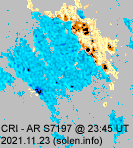 |
area: 0130 |
| S7198 | 2021.11.22 | S06W38 | |||||||||
| S7199 | 2021.11.23 | S30W29 |
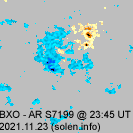 |
||||||||
| S7200 | 2021.11.23 | S32W12 |
 |
was initially reported as AR 12898 by SWPC | |||||||
| S7201 | 2021.11.24 | N04W02 |
 |
SC24 group | |||||||
| S7202 | 2021.11.24 | 2 | 2 | S02W06 | 0010 | BXO |
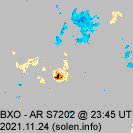 |
 |
SC24 group | ||
| S7203 | 2021.11.24 | 2 | 1 | S20W36 | 0003 | AXX |
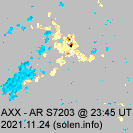 |
||||
| S7204 | 2021.11.24 | 1 | S24W23 | 0001 | AXX |
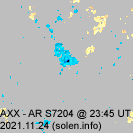 |
|||||
| Total spot count: | 9 | 31 | 16 | ||||||||
| Sunspot number: | 39 | 91 | 56 | (total spot count + 10 * number of spotted regions) | |||||||
| Weighted SN: | 12 | 36 | 21 | (Sum of total spot count + classification weighting for each AR. Classification weighting: X=0, R=3, A/S=5, H/K=10) | |||||||
| Relative sunspot number (Wolf number): | 43 | 50 | 45 | ||||||||
| Month | Average solar flux | International sunspot number (WDC-SILSO) |
Smoothed sunspot number (4) | Average ap (3) |
|
|---|---|---|---|---|---|
| Measured | 1 AU | ||||
| 2014.02 | 170.3 (cycle peak) |
166.3 | 146.1 (SC24 peak) | 110.5 | 10.70 |
| 2014.04 | 143.9 | 144.8 | 112.5 | 116.4 (solar max) | 7.88 |
| 2017.09 | 91.3 | 92.3 | 43.6 | 18.2 (-1.3) | 18.22 (cycle peak) |
| 2019.11 | 70.2 | 68.7 | 0.5 | 2.0 (-0.6) (Solar minimum using 365d smoothing: November 17, 2019) |
4.19 |
| 2019.12 | 70.8 | 68.6 | 1.6 | 1.8 (-0.2) (ISN 13 months smoothed solar minimum) |
3.22 |
| 2020.05 | 69.0 | 70.6 | 0.2 | 5.6 (+2.0) | 3.80 |
| 2020.06 | 69.5 | 71.7 | 5.8 | 7.9 (+2.3) | 3.75 |
| 2020.07 | 69.5 | 71.8 | 6.3 | 9.0 (+1.1) | 4.28 |
| 2020.08 | 71.6 | 73.4 | 7.6 | 9.5 (+0.5) | 5.68 |
| 2020.09 | 70.7 | 71.4 | 0.7 | 10.5 (+1.0) | 8.59 |
| 2020.10 | 74.6 | 74.2 | 14.6 | 11.9 (+1.4) | 6.13 |
| 2020.11 | 89.9 | 88.0 | 34.5 | 13.6 (+1.7) | 4.77 |
| 2020.12 | 86.9 | 84.2 | 23.1 | 15.3 (+1.7) | 4.72 |
| 2021.01 | 76.0 | 73.6 | 10.4 | 17.3 (+2.0) | 4.39 |
| 2021.02 | 74.3 | 72.4 | 8.3 | 19.1 (+1.8) | 9.50 |
| 2021.03 | 76.0 | 75.2 | 17.3 | 21.8 (+2.7) | 10.17 |
| 2021.04 | 75.9 | 76.4 | 24.5 | 24.9 (+3.1) | 8.40 |
| 2021.05 | 75.3 | 77.1 | 21.2 | (26.6 projected, +1.7) | 6.50 |
| 2021.06 | 79.4 | 81.8 | 25.3 | (29.8 projected, +3.2) | 5.52 |
| 2021.07 | 81.0 | 83.6 | 34.4 | (34.4 projected, +4.6) | 5.51 |
| 2021.08 | 77.7 | 79.7 | 22.4 | (39.1 projected, +4.7) | 6.19 |
| 2021.09 | 87.0 | 88.2 | 51.5 | (44.8 projected, +5.7) | 6.33 |
| 2021.10 | 88.9 | 88.3 | 38.1 | (49.1 projected, +4.3) | 7.38 |
| 2021.11 | 84.9 (1) | 26.5 (2A) / 33.1 (2B) / 51.7 (2C) | (53.7 projected, +4.6) | (11.1) | |
| 2021.12 | (59.6 projected, +5.9) | ||||
| 2022.01 | (63.2 projected, +3.6) | ||||
| 2022.02 | (67.9 projected, +4.7) | ||||
| 2022.03 | (73.4 projected, +5.5) | ||||
| 2022.04 | (78.5 projected, +5.1) | ||||
1) Running average based on the daily 20:00 UTC observed solar flux value at 2800 MHz
and any corrections applied to that measurement.
2A) Current impact on the monthly sunspot number based on the Boulder (NOAA/SWPC) sunspot number (accumulated daily sunspots / month days).
2B) Boulder SN current month average to date.
2C) STAR SDO 1K Wolf number 30 day average.
3) Running average based on the quicklook and definitive Potsdam WDC ap indices. Values in red
are based on the definitive international
GFZ Potsdam WDC ap indices.
4) Source: SIDC-SILSO.

This report has been prepared by Jan Alvestad. It is based on the analysis of data from whatever sources are available at the time the report is prepared. All time references are to Universal Time. Comments and suggestions are always welcome.
SDO images are courtesy of NASA/SDO and the AIA, EVE, and HMI science teams.